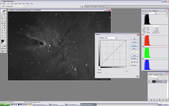Processing Practices - Software - Techniques - Tips
Articles/Tips |
Presentations |
Video Tutorials |

The Task of Image Processing - A useful glimpse into the steps of going from RAW data to finished image. Includes example workflow and reasons why we do what we do.
|

Photoshop Workflows - Given in 2014 at the Texas Star Party, this presentation steps you through the Photoshop Workflow, including processing tips, philosophy, and artistic advice.
|
People aren't used to buying software. In a world-wide software industry that made $8.8 billion in 2008, an estimated $53 billion was lost to software piracy, according to the Business Software Alliance's BSA-IDC Global Software Piracy Study. This means that when people need software, 59% of the time they actually purchase it legally.
Americans seem to be a bit more moral about it though. 80% of the time, they will shill out the money for it, but because the U.S. is the largest industry, it suffers the greatest loss from piracy - $9.1 billion in 2008 alone.
And now, in the presence of the 99 cent "app," who would want to pay typical PC software prices? Piracy will continue to happen.
Perhaps this helps to explain why software is an afterthought when it comes to budgeting for this hobby? We seem to have no problem planning for a $275 camera adapter or eyepiece but - gulp!- for software?
Shouldn't that stuff come with the computer?
But if this hobby is anything, it's about technology. But even if you shoot DSLR images on a tripod, you still will need software in this hobby. And that means you better plan to purchase some from the very start.
But fear not! Your compatriots in this hobby, where most of our software comes from, are producing some awesome software. So good, in fact, that much of it is very reasonably priced for all that it does. One piece of software, the planetary processing software called "Registax," is even free - perhaps the most understated software value since the cavemen first invented binary code.
Don't believe me. Just ask veterans in this hobby, across the land and sea, how much they'd be willing to pay for Registax if it were no longer free? $100? $300? $500?
In total, the software readily available to the amateur astroimager is astonishing in capability, amazingly reasonable in value, and capable of making your astrophotography career much more simple. For the price of your nice small apo refractor you can develop a highly-sophisticated, computer-based, totally robotic astroimaging setup should you desire. If Edwin Hubble were alive, he'd likely be as impressed by your imaging rig as he would be his namesake telescope. (Yeah, I admit it. I didnt know who the guy was before the Hubble Space Telescope.)
This page is about software and the techniques needed to process your data. It is NOT here to make you feel guilty for past software transgressions. Neither do I expect you will run out right away and purchase the entire Adobe Creative Suite, right? Because, afterall, if you are going to spend serious bucks on Photoshop, you might as well buy the whole ball of Adobe wax!
Instead, let's look at some of the things you can do with the software being used by many in the hobby today.
Americans seem to be a bit more moral about it though. 80% of the time, they will shill out the money for it, but because the U.S. is the largest industry, it suffers the greatest loss from piracy - $9.1 billion in 2008 alone.
And now, in the presence of the 99 cent "app," who would want to pay typical PC software prices? Piracy will continue to happen.
Perhaps this helps to explain why software is an afterthought when it comes to budgeting for this hobby? We seem to have no problem planning for a $275 camera adapter or eyepiece but - gulp!- for software?
Shouldn't that stuff come with the computer?
But if this hobby is anything, it's about technology. But even if you shoot DSLR images on a tripod, you still will need software in this hobby. And that means you better plan to purchase some from the very start.
But fear not! Your compatriots in this hobby, where most of our software comes from, are producing some awesome software. So good, in fact, that much of it is very reasonably priced for all that it does. One piece of software, the planetary processing software called "Registax," is even free - perhaps the most understated software value since the cavemen first invented binary code.
Don't believe me. Just ask veterans in this hobby, across the land and sea, how much they'd be willing to pay for Registax if it were no longer free? $100? $300? $500?
In total, the software readily available to the amateur astroimager is astonishing in capability, amazingly reasonable in value, and capable of making your astrophotography career much more simple. For the price of your nice small apo refractor you can develop a highly-sophisticated, computer-based, totally robotic astroimaging setup should you desire. If Edwin Hubble were alive, he'd likely be as impressed by your imaging rig as he would be his namesake telescope. (Yeah, I admit it. I didnt know who the guy was before the Hubble Space Telescope.)
This page is about software and the techniques needed to process your data. It is NOT here to make you feel guilty for past software transgressions. Neither do I expect you will run out right away and purchase the entire Adobe Creative Suite, right? Because, afterall, if you are going to spend serious bucks on Photoshop, you might as well buy the whole ball of Adobe wax!
Instead, let's look at some of the things you can do with the software being used by many in the hobby today.

